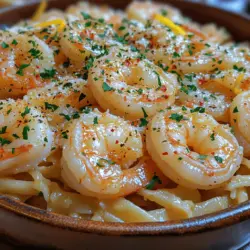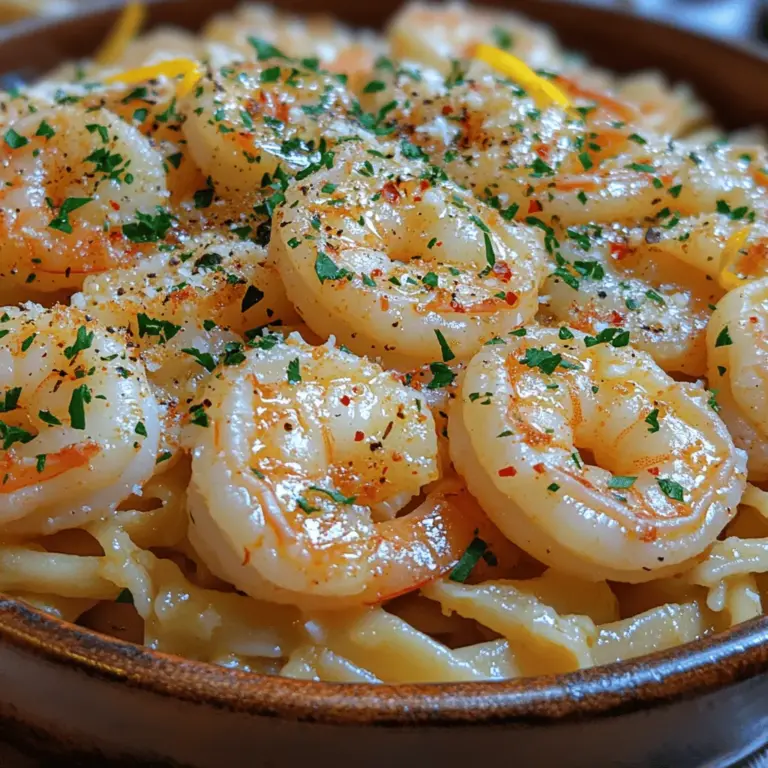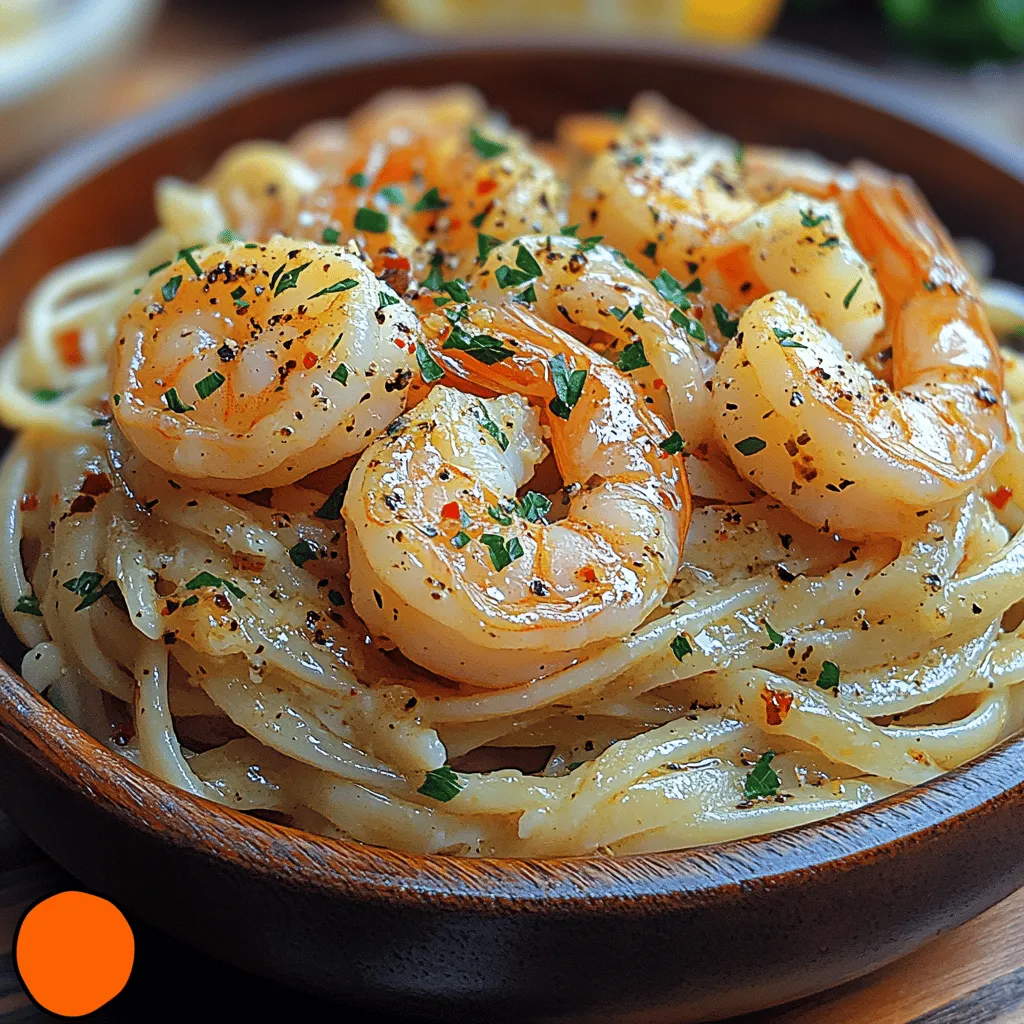Introduction
Shrimp Scampi Linguine is a delightful dish that perfectly marries the flavors of succulent shrimp and al dente linguine in a rich, buttery sauce. This seafood pasta dish is not only quick and easy to prepare but also delivers a gourmet experience that impresses family and friends alike. Originating from Italian-American cuisine, Shrimp Scampi combines the best elements of coastal cooking, making it a beloved choice for seafood lovers around the world. The dish’s simplicity is deceptive; with just a handful of quality ingredients, you can create a meal that feels indulgent and sophisticated.
In this comprehensive guide, we will delve into the details of creating this classic Italian-American dish, highlighting its ingredients, preparation methods, and variations that can elevate your dining experience. Whether you’re an experienced chef or a cooking novice, this guide will help you master the art of Shrimp Scampi Linguine.
The Allure of Shrimp Scampi
Understanding the Appeal of Shrimp Scampi
What makes Shrimp Scampi so enticing? The answer lies in its harmonious blend of flavors and textures. The plump, juicy shrimp pair beautifully with the tender linguine, all enveloped in a luscious, garlicky butter sauce. The dish is often garnished with freshly chopped parsley and a squeeze of zesty lemon, which brightens the overall flavor profile. This combination not only tantalizes the taste buds but also creates a visually appealing plate that is perfect for entertaining.
The allure of Shrimp Scampi extends beyond its flavor. Its quick preparation time makes it an excellent choice for busy weeknights or spontaneous dinner parties. In less than 30 minutes, you can whip up a dish that feels like it belongs in a five-star restaurant. This convenience, alongside its rich taste and aesthetic appeal, solidifies Shrimp Scampi as a favorite among home cooks.
Exploring the History and Origins of the Dish
The origins of Shrimp Scampi can be traced back to the coastal regions of Italy, particularly in the south, where seafood is a staple. The term “scampi” traditionally refers to a type of langoustine, a small lobster-like crustacean found in the Mediterranean. Over time, however, the dish evolved, especially in America, to feature shrimp as the primary ingredient. This adaptation reflects the culinary creativity and resourcefulness of Italian immigrants who sought to recreate the flavors of their homeland with the seafood readily available to them.
In the United States, Shrimp Scampi gained popularity in the mid-20th century, particularly in Italian-American communities. It quickly became a beloved dish in restaurants and homes alike, often served with spaghetti or linguine. Today, it stands as a testament to the versatility of Italian cuisine, showcasing how traditional recipes can be adapted and embraced by different cultures.
Why Shrimp Scampi is a Popular Choice for Home Cooks
One of the reasons Shrimp Scampi remains a go-to dish for home cooks is its versatility. The recipe can be easily modified to suit personal tastes and dietary needs. For instance, you can experiment with various types of pasta, add seasonal vegetables, or adjust the level of spice to your liking. This adaptability makes Shrimp Scampi a suitable option for various occasions, whether you’re hosting a fancy dinner party or preparing a casual family meal.
Furthermore, the ingredients in Shrimp Scampi are often pantry staples, making it easy to whip up on short notice. With shrimp, pasta, garlic, and a few other essentials, you can create a restaurant-quality dish without the need for elaborate preparations or hard-to-find ingredients. This accessibility is a significant factor in its enduring popularity among home cooks of all skill levels.
Ingredients Breakdown
To create the perfect Shrimp Scampi Linguine, it’s essential to use high-quality ingredients. Each component plays a crucial role in achieving the dish’s signature flavor and texture. Here’s a detailed breakdown of the essential ingredients you’ll need:
Essential Ingredients for Shrimp Scampi Linguine
– Linguine Pasta: Choosing the Right Type
Linguine is the classic choice for this dish, as its flat, narrow shape allows it to hold onto the sauce beautifully. When selecting linguine, opt for high-quality pasta made from durum wheat for optimal texture and flavor. You can also experiment with whole wheat or gluten-free options if desired. Cooking the linguine to al dente ensures that it will maintain a pleasant bite and not become mushy when combined with the sauce.
– Shrimp: Fresh vs. Frozen – What to Consider
When it comes to shrimp, freshness is key. If you have access to fresh shrimp, use them for their superior flavor and texture. Look for shrimp that are firm, translucent, and have a mild scent. If fresh shrimp are not available, frozen shrimp are a convenient alternative. Make sure to choose high-quality frozen shrimp, ideally those that are wild-caught. When using frozen shrimp, thaw them properly before cooking, either in the refrigerator overnight or by placing them in a sealed bag and submerging them in cold water for about 30 minutes.
– The Role of Butter and Olive Oil in the Sauce
A combination of butter and olive oil forms the base of the sauce, imparting richness and depth of flavor. Butter enhances the dish’s creaminess and adds a luxurious touch, while olive oil contributes a fruity note that balances the richness. For the best results, use unsalted butter to allow you to control the saltiness of the dish. Extra virgin olive oil is recommended for its robust flavor, but you can also use a lighter olive oil if preferred.
– Garlic: The Flavor Foundation
Garlic is the heart of the sauce, providing a fragrant aroma and savory depth. Fresh garlic cloves are ideal; they can be minced or thinly sliced to release their oils. It’s essential to sauté the garlic just until fragrant to avoid burning, which can impart a bitter taste to the dish. If you love garlic, feel free to adjust the quantity to suit your preference.
– Understanding the Use of White Wine in Cooking
White wine not only adds acidity to the dish but also enhances the overall flavor profile. It helps to deglaze the pan, lifting the fond (the browned bits left in the pan) and infusing the sauce with deliciousness. A dry white wine, such as Sauvignon Blanc or Pinot Grigio, is recommended. If you prefer not to use wine, you can substitute it with chicken or vegetable broth, but be aware that the flavor will differ slightly.
– The Importance of Fresh Herbs: Parsley and Lemon
Fresh herbs, particularly parsley, add brightness and color to Shrimp Scampi Linguine. Chopped parsley should be added just before serving to retain its vibrant flavor. A squeeze of fresh lemon juice is also crucial; it brightens the dish and balances the richness of the sauce. For a touch of elegance, you can also zest the lemon and sprinkle it over the finished dish for an extra burst of citrus flavor.
Preparing Shrimp Scampi Linguine
With your ingredients gathered, it’s time to dive into the preparation of Shrimp Scampi Linguine. The following step-by-step guide will ensure that your dish turns out perfectly every time.
Step-by-Step Guide to Cooking Shrimp Scampi Linguine
Cooking the Linguine: Techniques for Perfect Pasta
1. Boil Water: Start by bringing a large pot of salted water to a rolling boil. The salt is crucial as it seasons the pasta while it cooks. A good rule of thumb is to add about 1 tablespoon of salt for every 4-6 quarts of water.
2. Add Linguine: Once the water is boiling, add the linguine. Stir gently to prevent the pasta from sticking together. Check the package instructions for cooking time, but generally, linguine should be cooked for about 8-10 minutes for al dente.
3. Reserve Pasta Water: Before draining the pasta, reserve about a cup of the starchy pasta water. This can be added to the sauce later to adjust the consistency and help the sauce adhere to the pasta.
4. Drain and Rinse: Drain the linguine in a colander but avoid rinsing it, as you want to retain the starch that helps the sauce cling.
Preparing the Shrimp: Tips for Cleaning and Seasoning
1. Clean the Shrimp: If using fresh shrimp, rinse them under cold water and remove the shells. Use a sharp knife or your fingers to devein the shrimp by making a shallow cut along the back and pulling out the dark vein. If using frozen shrimp, ensure they are fully thawed and cleaned before proceeding.
2. Season the Shrimp: Lightly season the cleaned shrimp with salt and pepper. You can also sprinkle a pinch of paprika or cayenne pepper for a hint of spice if desired.
Sautéing Garlic and Red Pepper Flakes: Achieving the Right Aroma
1. Heat the Pan: In a large skillet, heat a mixture of olive oil and butter over medium heat. Allow the butter to melt completely without browning.
2. Add Garlic: Once the butter has melted, add the minced garlic and red pepper flakes to the skillet. Sauté for about 30 seconds until fragrant, stirring constantly to prevent burning.
3. Add the Shrimp: Increase the heat to medium-high and add the seasoned shrimp to the skillet. Cook for 2-3 minutes on each side, or until the shrimp turn pink and opaque. Be careful not to overcook them, as shrimp can become rubbery if left on the heat for too long.
The Perfect Shrimp: Cooking Time and Temperature Considerations
1. Deglaze the Pan: Once the shrimp are cooked, carefully pour in the white wine, scraping the bottom of the pan to release any browned bits. Allow the wine to reduce by half, which should take about 2-3 minutes.
2. Combine with Linguine: Add the cooked linguine directly to the skillet with the shrimp and sauce. Toss everything together, ensuring the pasta is well-coated. If the sauce seems too thick, gradually add the reserved pasta water until you achieve the desired consistency.
3. Finish with Fresh Herbs and Lemon: Just before serving, remove the skillet from the heat and stir in freshly chopped parsley and a generous squeeze of lemon juice. Adjust the seasoning with salt and pepper if needed.
With these steps, you’re well on your way to creating a delicious Shrimp Scampi Linguine that will delight your taste buds and impress your guests. The combination of flavors and the ease of preparation make this dish a must-try for any seafood lover. Stay tuned for the next part, where we will explore additional tips and variations to elevate your Shrimp Scampi experience even further.
Deglazing the Pan: Enhancing Flavor with Wine
Once your shrimp is perfectly cooked and has taken on a beautiful pink hue, it’s time to deglaze the pan. This crucial step not only adds depth to your dish but also ensures that none of the delicious flavors are left behind. Here’s how to do it:
1. Remove the Shrimp: Carefully take the cooked shrimp out of the pan and set them aside on a warm plate to keep them from cooling down.
2. Add White Wine: With the heat still on medium-high, pour in about half a cup of dry white wine. As the wine hits the pan, you’ll hear that satisfying sizzle. This is the sound of flavor being unlocked.
3. Scrape the Bits: Use a wooden spoon to scrape up any browned bits stuck to the bottom of the pan. These bits, known as fond, are packed with flavor and will elevate your sauce.
4. Reduce the Wine: Allow the wine to simmer for about 2-3 minutes, letting it reduce slightly. As the alcohol cooks off, the flavor will intensify, creating a rich base for your sauce.
Combining Ingredients: Achieving the Right Consistency
Once the wine has reduced, it’s time to bring everything together.
1. Add the Shrimp Back: Return the shrimp to the pan along with any juices that may have accumulated on the plate.
2. Add the Linguine: Now add your cooked linguine directly to the pan. If you haven’t done so already, ensure your pasta is al dente for the best texture.
3. Incorporate Sauce Ingredients: Pour in about a quarter cup of reserved pasta water—this starchy water is your secret weapon for creating a silky sauce. Toss everything together gently, ensuring the shrimp and pasta are well-coated with the wine sauce.
4. Adjust Consistency: If the mixture seems too dry, feel free to add more pasta water, a little at a time, until you reach your desired consistency. The goal is a light sauce that clings to the pasta without being overly saucy.
Finishing Touches: Herbs and Seasoning Adjustments
To round out your dish, it’s time for the finishing touches.
1. Herbs: Remove the pan from heat and stir in freshly chopped parsley for a burst of color and flavor. Adding the herbs off the heat helps to preserve their vibrant color and fresh taste.
2. Seasoning Adjustments: Taste your dish and adjust the seasoning. You may find it needs a pinch of salt or a sprinkle of freshly ground black pepper. For a hint of acidity, consider squeezing fresh lemon juice over the top just before serving.
Serving Suggestions
Now that your Shrimp Scampi Linguine is perfectly prepared, let’s explore how to present it beautifully and enhance the meal experience.
Presentation Ideas for Shrimp Scampi Linguine
– Choosing the Right Plateware for a Gourmet Look: Opt for large, shallow bowls or elegant pasta plates to serve your dish. A white or cream-colored plate allows the vibrant colors of the shrimp and herbs to pop, creating an inviting presentation.
– Garnishing: Finish your plate with a light sprinkle of freshly grated Parmesan cheese and additional chopped parsley. A lemon wedge on the side not only enhances the presentation but also allows diners to customize their flavor.
Pairing with Wine: Recommendations for Complementary Choices
With Shrimp Scampi Linguine, a crisp white wine is an ideal pairing. Here are a few suggestions:
– Pinot Grigio: Its light body and refreshing acidity complement the richness of the dish.
– Sauvignon Blanc: This wine’s grassy notes and zesty citrus flavors will enhance the shrimp and garlic beautifully.
– Chardonnay: For those who prefer a fuller-bodied wine, a lightly oaked Chardonnay can provide a nice balance with the richness of the olive oil.
Sides That Complement Shrimp Scampi Linguine
To create a well-rounded meal, consider serving your Shrimp Scampi Linguine with these side dishes:
– Garlic Bread: Perfect for sopping up any leftover sauce, garlic bread is a classic accompaniment to pasta.
– Caesar Salad: The crisp romaine and creamy dressing offer a refreshing contrast to the rich pasta.
– Steamed Vegetables: Lightly steamed asparagus or broccoli add color and nutrients to your meal without overshadowing the main dish.
Variations and Customizations
While the classic Shrimp Scampi Linguine is undeniably delicious, there are plenty of ways to customize it to suit your tastes or dietary preferences.
Adding Vegetables: Spinach, Tomatoes, and More
Incorporating vegetables not only boosts the nutritional value but also adds color and texture:
– Spinach: Stir in a couple of cups of fresh spinach at the end of cooking; it wilts down beautifully and adds a nutrient boost.
– Cherry Tomatoes: Halved cherry tomatoes can be added during the last few minutes of cooking for a burst of sweetness and acidity.
Alternative Proteins: Scallops, Chicken, or Vegetarian Options
For those looking to switch things up, consider these alternatives:
– Scallops: Substitute or combine shrimp with scallops for a luxurious twist. Sear them separately before adding them back to the dish.
– Chicken: Cook bite-sized pieces of chicken breast in the same manner as shrimp for a heartier option.
Spicy Shrimp Scampi: Adjusting Heat Levels
If you enjoy a kick of heat, you can easily spice up your Shrimp Scampi:
– Red Pepper Flakes: Add a pinch of red pepper flakes while sautéing the garlic for a subtle heat.
– Jalapeños: For a bolder spice, finely chop jalapeños and sauté them with the garlic.
Nutritional Information
Understanding the nutritional profile of your dish can help you make informed choices.
Caloric Content and Serving Size Considerations
A typical serving of Shrimp Scampi Linguine (approximately 1.5 cups) contains around 500-600 calories, depending on the amount of olive oil and pasta used.
Health Benefits of Shrimp and Olive Oil
– Shrimp: A great source of lean protein, shrimp is low in calories and rich in essential nutrients like selenium and vitamin B12.
– Olive Oil: Packed with healthy fats, olive oil is known for its anti-inflammatory properties and is a staple of the Mediterranean diet.
Balancing Your Meal with Side Dishes
To create a balanced meal, focus on portion sizes. If you’re serving the pasta as a main dish, consider smaller portions of bread and salad to keep the overall meal in check.
Conclusion
Shrimp Scampi Linguine is more than just a meal; it’s a delightful culinary experience that combines simplicity with exquisite taste. With its rich flavors and quick preparation time, this dish is perfect for weeknight dinners or special occasions. By following the steps outlined above, you can create a restaurant-quality dish right in your own kitchen. Embrace the art of cooking and enjoy the journey of making this classic Italian-American pasta dish that is sure to please any palate. Whether you stick to the traditional recipe or experiment with variations, the joy of sharing this dish with loved ones will make it a memorable experience. Bon appétit!


